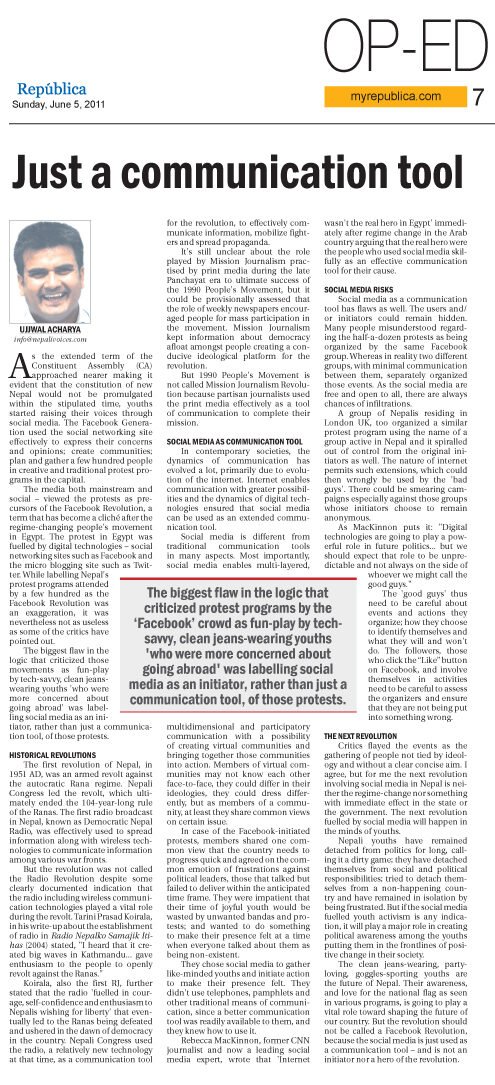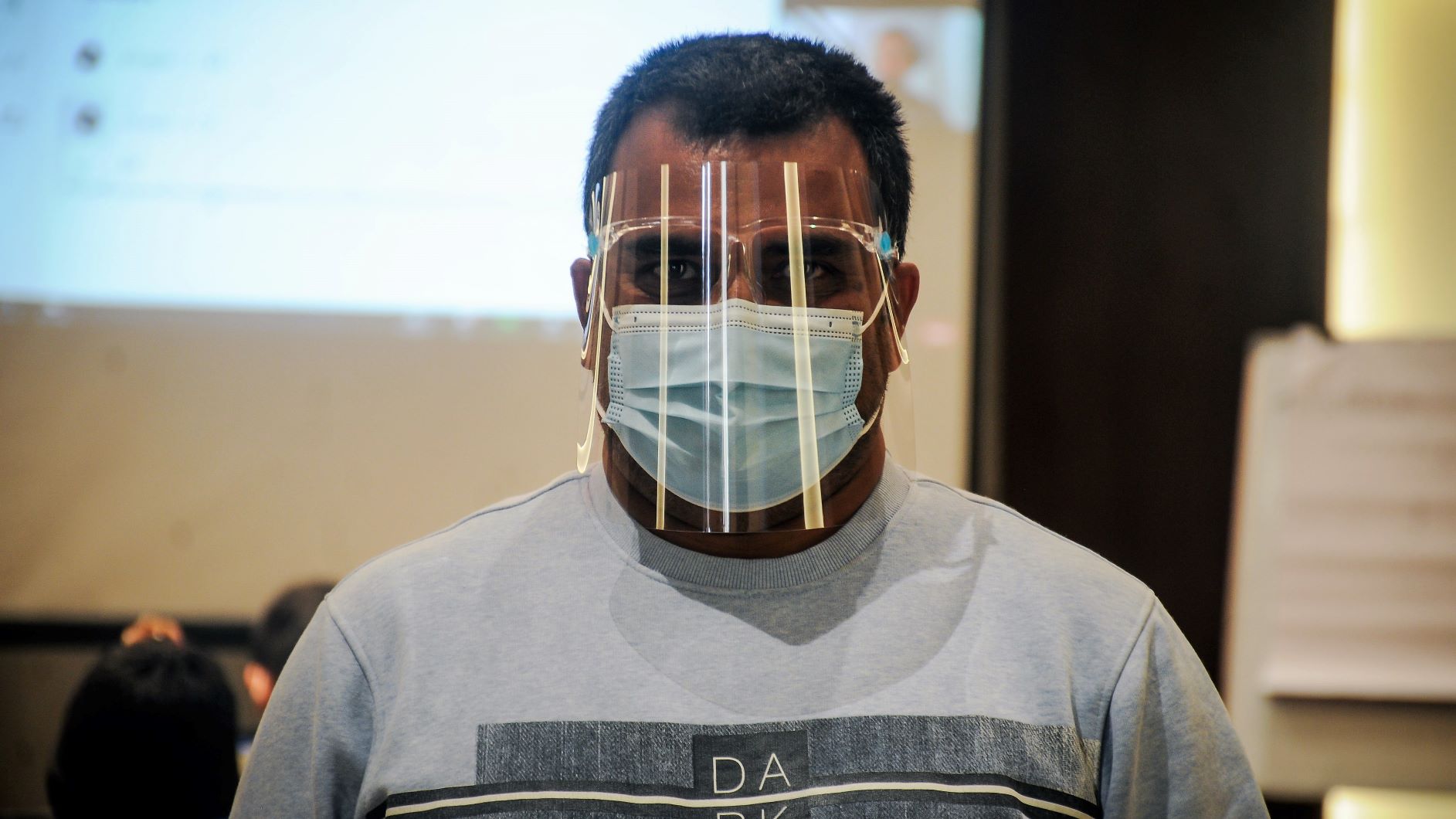As the extended term of the Constituent Assembly (CA) approached nearer making it evident that the constitution of new Nepal would not be promulgated within the stipulated time, youths started raising their voices through social media. The Facebook Generation used the social networking site effectively to express their concerns and opinions; create communities; plan and gather a few hundred people in creative and traditional protest programs in the capital.
The media both mainstream and social – viewed the protests as precursors of the Facebook Revolution, a term that has become a cliché after the regime-changing people´s movement in Egypt. The protest in Egypt was fuelled by digital technologies – social networking sites such as Facebook and the micro blogging site such as Twitter. While labelling Nepal´s protest programs attended by a few hundred as the Facebook Revolution was an exaggeration, it was nevertheless not as useless as some of the critics have pointed out.
The biggest flaw in the logic that criticized those movements as fun-play by tech-savvy, clean jeans-wearing youths ´who were more concerned about going abroad´ was labelling social media as an initiator, rather than just a communication tool, of those protests.
HISTORICAL REVOLUTIONS
 The first revolution of Nepal, in 1951 AD, was an armed revolt against the autocratic Rana regime. Nepali Congress led the revolt, which ultimately ended the 104-year-long rule of the Ranas. The first radio broadcast in Nepal, known as Democratic Nepal Radio, was effectively used to spread information along with wireless technologies to communicate information among various war fronts.
The first revolution of Nepal, in 1951 AD, was an armed revolt against the autocratic Rana regime. Nepali Congress led the revolt, which ultimately ended the 104-year-long rule of the Ranas. The first radio broadcast in Nepal, known as Democratic Nepal Radio, was effectively used to spread information along with wireless technologies to communicate information among various war fronts.
But the revolution was not called the Radio Revolution despite some clearly documented indication that the radio including wireless communication technologies played a vital role during the revolt. Tarini Prasad Koirala, in his write-up about the establishment of radio in Radio Nepalko Samajik Itihas (2004) stated, “I heard that it created big waves in Kathmandu… gave enthusiasm to the people to openly revolt against the Ranas.”
Koirala, also the first RJ, further stated that the radio ´fuelled in courage, self-confidence and enthusiasm to Nepalis wishing for liberty´ that eventually led to the Ranas being defeated and ushered in the dawn of democracy in the country. Nepali Congress used the radio, a relatively new technology at that time, as a communication tool for the revolution, to effectively communicate information, mobilize fighters and spread propaganda.
The biggest flaw in the logic that criticized protest programs by the ‘Facebook’ crowd as fun-play by tech-savvy, clean jeans-wearing youths ´who were more concerned about going abroad´ was labelling social media as an initiator, rather than just a communication tool, of those protests.
It´s still unclear about the role played by Mission Journalism practised by print media during the late Panchayat era to ultimate success of the 1990 People´s Movement, but it could be provisionally assessed that the role of weekly newspapers encouraged people for mass participation in the movement. Mission Journalism kept information about democracy afloat amongst people creating a conducive ideological platform for the revolution.
But 1990 People´s Movement is not called Mission Journalism Revolution because partisan journalists used the print media effectively as a tool of communication to complete their mission.
SOCIAL MEDIA AS COMMUNICATION TOOL
In contemporary societies, the dynamics of communication has evolved a lot, primarily due to evolution of the internet. Internet enables communication with greater possibilities and the dynamics of digital technologies ensured that social media can be used as an extended communication tool.
Social media is different from traditional communication tools in many aspects. Most importantly, social media enables multi-layered, multidimensional and participatory communication with a possibility of creating virtual communities and bringing together those communities into action. Members of virtual communities may not know each other face-to-face, they could differ in their ideologies, they could dress differently, but as members of a community, at least they share common views on certain issue.
In case of the Facebook-initiated protests, members shared one common view that the country needs to progress quick and agreed on the common emotion of frustrations against political leaders, those that talked but failed to deliver within the anticipated time frame. They were impatient that their time of joyful youth would be wasted by unwanted bandas and protests; and wanted to do something to make their presence felt at a time when everyone talked about them as being non-existent.
They chose social media to gather like-minded youths and initiate action to make their presence felt. They didn´t use telephones, pamphlets and other traditional means of communication, since a better communication tool was readily available to them, and they knew how to use it.
Rebecca MacKinnon, former CNN journalist and now a leading social media expert, wrote that ´Internet wasn´t the real hero in Egypt´ immediately after regime change in the Arab country arguing that the real hero were the people who used social media skilfully as an effective communication tool for their cause.
SOCIAL MEDIA RISKS
Social media as a communication tool has flaws as well. The users and/or initiators could remain hidden. Many people misunderstood regarding the half-a-dozen protests as being organized by the same Facebook group. Whereas in reality two different groups, with minimal communication between them, separately organized those events. As the social media are free and open to all, there are always chances of infiltrations.
A group of Nepalis residing in London UK, too organized a similar protest program using the name of a group active in Nepal and it spiralled out of control from the original initiators as well. The nature of internet permits such extensions, which could then wrongly be used by the ´bad guys´. There could be smearing campaigns especially against those groups whose initiators choose to remain anonymous.
As MacKinnon puts it: “Digital technologies are going to play a powerful role in future politics… but we should expect that role to be unpredictable and not always on the side of whoever we might call the good guys.”
The ´good guys´ thus need to be careful about events and actions they organize; how they choose to identify themselves and what they will and won´t do. The followers, those who click the “Like” button on Facebook, and involve themselves in activities need to be careful to assess the organizers and ensure that they are not being put into something wrong.
THE NEXT REVOLUTION
Critics flayed the events as the gathering of people not tied by ideology and without a clear concise aim. I agree, but for me the next revolution involving social media in Nepal is neither the regime-change nor something with immediate effect in the state or the government. The next revolution fuelled by social media will happen in the minds of youths.
Nepali youths have remained detached from politics for long, calling it a dirty game; they have detached themselves from social and political responsibilities; tried to detach themselves from a non-happening country and have remained in isolation by being frustrated. But if the social media fuelled youth activism is any indication, it will play a major role in creating political awareness among the youths putting them in the frontlines of positive change in their society.
The clean jeans-wearing, party-loving, goggles-sporting youths are the future of Nepal. Their awareness, and love for the national flag as seen in various programs, is going to play a vital role toward shaping the future of our country. But the revolution should not be called a Facebook Revolution, because the social media is just used as a communication tool – and is not an initiator nor a hero of the revolution.
(As published in Republica Op-Ed)

